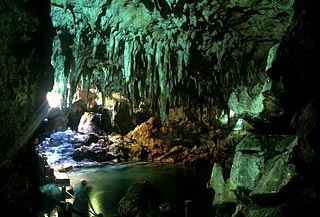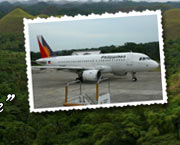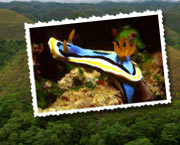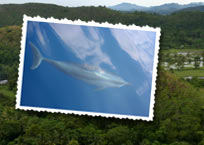Bohol, Cave Country
IJsselstein, Sunday, 7 April 2002 (updated: Friday, 17 March 2006)
The island province of Bohol may aptly be called "Cave Country." Some 1400 caves have been counted, and probably many more have escaped notice. Some claim that Bohol even got its name from the word "buho", meaning "hole.", although that term is actually applied to a hole from which spring water leaves the ground -- something you can find quite often in the coastal towns of the island.
Bohol, like the surrounding islands, emerged from the sea during the mid Tertiary, some 20-30 million years ago. The island is made of extensive karst (limestone) formations, such as sinkholes, ravines, the curious Chocolate Hills, and a large number of caves, many of them still unexplored. You may also come across streams that pop up from the ground at one place, to disappear again into a cave a few kilometers further on, and reappear again after running some distance underground. If you enter this underground world, you will encounter the many unusual and even bizarre invertebrates, such as albino crabs, that have evolved here and are especially adapted to this life in darkness.
All these caves of course are an ideal hideout, and have played an important role in Bohol's history. The Francisco Dagohoy Cave in the town of Danao is probably the most famous of these. This cave was the headquarters of the Boholano patriot Dagohoy, who, in the year 1744 started a rebellion against Spain that was to last until 1829. One of the many crystal-studded passages within Dagohoy's cave has an underwater route leading to dry land, and it is said that every time Spaniards would search the cave, Dagohoy would swim underwater through this passage to hide in the breathing space.
Well known, and easy to reach is Hinagdanan ("laddered" in Cebuano) cave on the island of Panglao, just 2.5 kilometers from Dauis. This cave has a large number of stalactites hanging from the sealing, and

|
| Hinagdanan Cave. |
| Copyright Harry Boer of Harrys Diaschau |
The inland town of Antequera, surrounded by hills and best known for its basket market, has a number of caves. They vary in difficulty. Close to town is Buhong Tiawan, one and half kilometer from the town center. To reach the entrance, in the wall of a limestone hill, you will have to walk about one kilometer through dense vegetation. The entrance itself is about 3 by 5 meters wide, and leads to a cavern that is less than 100 meters long. Inside you'll find various types of dripstone. During the Second World war, this cave served as a refuge for the locals, but was discovered and raided by the Japanese imperial army. Today, the cave is the home of bats and birds.
Two kilometers out of town lies Hagakgak cave. Again, you will have follow a trail through dense vegetation. Located about two kilometers from the town center, the cave is still quite undisturbed. The entrance is a 15 meters wide pasasge at the base of a sinkhole. This cave is a bit more difficult, and it can be quite wet and muddy inside. To get enter, you'll at times have to wriggle yourself through some narrow passages, but once inside, you'll be rewarded with some nice stalactites and stalagmites. This cave is the home of some animals which have adapted to a live underground, such as the rare albino crabs of the species sundathelphosa filipina and fishes.
If you're really into caving, you'll probably also want to be challenged by Inambacan cave. Also about two kilometers from the town of Antequera, you can get to the entrance of this cave over more accessible roads. Inside Inambacan cave is flowing water, which often fills most of the cave -- often the water is over 1.20 meters deep, and often only a mere 30 centimeters of air remain between the current and the ceiling. Inside the cave are some small stalactites and stalagmites. Don't go here without some experience in spelunking.
Roughly halfway the Southeastern coast of Bohol lies the town of Jagna. Best known because from here the boats to Mindanao and Butuan depart three times a week. However, the town also has a large number of caves, including the deepest cave in the Central Visayas. Carmaloan 2. This cave goes down to a depth of 149 meters. If you want to explore it, plan to stay in town for at least one night.
The largest cave in the province is Sudlon. This cave is located in a lovely mountain environment and serves as a hide-out for a huge population of bats. At dusk, you can see them emerge from the cave like large storm clouds.
|
Jeroen Hellingman
What readers think...
| Francis wrote: |
| Tuesday, 1 March 2016 12:49:31 PHT |
| We have a property accessible to hinagdanan cave. if you want to live in pangalo, we offer you affordable lot to buy through an easy installment. Inquire me for more details. We have 5 lots left, so hurry.. |
| Debra wrote: |
| Thursday, 13 October 2011 15:33:05 PHT |
| I'm from bohol but i've only seen the hinagdanan cave in dauis. how i wish i could see the other caves, esp. the one in s bullones described by vic ybalez. and yes, dagohoy's cave, too. bohol may be small but it really has a lot to offer. |
| Aiz wrote: |
| Wednesday, 27 April 2011 11:22:51 PHT |
| Hai happy day! meron din cave sa Trinidad so nice and adventurous. kakatakot nga eh ... hehehehe |
| Manuel Gallegos wrote: |
| Friday, 18 February 2011 05:46:18 PHT |
| Can you more experienced travelers to this part of the world give me some advise? What other islands are worth the visit to see rain forest? please let me know yourdreamscanhappen@yahoo.com thank you |
| Mcbride wrote: |
| Tuesday, 30 November 2010 16:51:46 PHT |
| maaung hapon sa tanan! @ vic ybalez: ask lang ko unsa name sa cave man nga naa sa sierra bullones? is it safe to bring a DSLR camera inside? As in mulosong ba gyud ka sa tubig? Asa pwede contakon ang moguide pasulod sa cave? censya dghan pangutana.:) planning to explore bisan usa lang ka langub sa bohol. Im going home this coming Jan 2011. So, murag naganyar ko sa imong post nga dunay waterfalls sulod sa langub. hope to hear from you soon..... cheers, mcbride |
Read all 93 comments by readers.
Also give your comments on this article
We reserve the right to remove or edit comments posted on this website. Please read our conditions of use for details. You can use <i>italics</i>, <b>bold</b>, <p> new paragraph, <a href="url">link</a>. Other markup will be removed. Use of the forums for advertising is prohibited. Enterprises located in Bohol can request to be added to the business directory.





